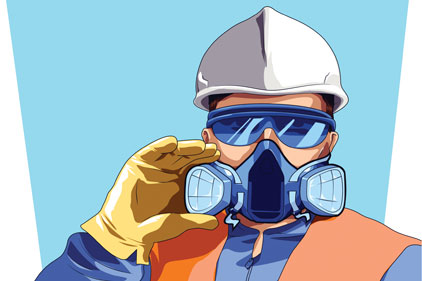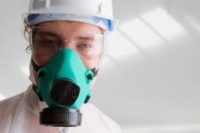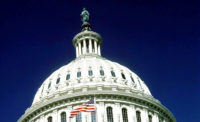When is respirator use required?
OSHA’s respirator standard, 29 CFR 1910.134, requires the use of respirators to protect employees from breathing contaminated and/or oxygen-deficient air when effective engineering controls are not feasible, or while they are being instituted. Several other OSHA regulations also require the use of respirators.
Can any respirator be used?
No, respirators shall be selected on the basis of hazards to which the worker is exposed (i.e., particulates, vapors, oxygen-deficiency, or combination). Also, OSHA requires the use of certified respirators.
Why is a formal respirator program needed?
A respirator program increases the chances of using a respirator correctly. A respirator will only protect if it is used correctly. Also, OSHA requires a number of written elements for all respiratory protection programs.
What do employees need to know about the respirator program?
Employers must establish and implement a written respiratory protection program with worksite-specific procedures and elements for required respirator use. Provisions of the program include procedures for selection, medical evaluation, fit testing, training, use and care of respirators.
How is proper respirator size determined?
Proper respirator size is determined through a fit test. Employees using negative or positive pressure tight-fitting facepiece respirators must pass an appropriate fit test using the procedures detailed in OSHA’s respirator standard.
Can employees check the fit of their own respirator?
Yes, employees using tight-fitting facepiece respirators are required to perform a user seal check each time they put on the respirator. They must use the procedures in Appendix B-1 of 29 CFR 1910.134 or procedures recommended by the respirator manufacturer that the employer demonstrates are as effective as OSHA’s procedures. Note that a fit test is a method used to select the right size respirator for the user. A user seal check is a method to verify that the user has correctly put on the respirator and adjusted it to fit properly.
When is respirator fit testing required?
Fit testing of all negative or positive pressure tight-fitting facepiece respirators is required prior to initial use, whenever a different respirator facepiece is used, and at least annually thereafter. An additional fit test is required whenever there are changes in the user’s physical condition that could affect respirator fit (e.g., facial scarring, dental changes, cosmetic surgery, or an obvious change in body weight). The employer must be fit tested with the same make, model, style and size of respirator that will be used.
Must employees see a doctor before they use a respirator?
The employer must provide a medical evaluation to determine the employee’s ability to use a respirator before the employee is fit tested or required to use the respirator in the workplace. Not all workers must be examined by a doctor. A physician or other licensed health care professional must perform the medical evaluation using the medical questionnaire contained in Appendix C of 29 CFR 1910.134 or an initial medical examination that obtains the same information.
What maintenance and care is required for respirators?
The employer must provide for the cleaning and disinfecting, storage, inspection and repair of respirators used by employees according to the procedures in 29 CFR 1910.134.
Can a respirator be used by more than one person?
Disposable respirators cannot be disinfected, and are therefore assigned to only one person. Disposable respirators must be discarded if they are soiled, physically damaged, or reach the end of their service life. Replaceable filter respirators may be shared, but must be thoroughly cleaned and disinfected after each use before being worn by a different person, using the procedures in Appendix B-2 of 29 CFR 1910.134, or equally effective procedures recommended by the manufacturer.
How long can a particulate respirator be used before it must be discarded?
Respirators with replaceable filters are reusable, and a respirator classified as disposable may be reused by the same worker as long as it functions properly. All filters must be replaced whenever they are damaged, soiled, or causing noticeably increased breathing resistance (e.g., causing discomfort to the wearer). Before each use, the outside of the filter material should be inspected. If the filter material is physically damaged or soiled, the filter should be changed (in the case of respirators with replaceable filters) or the respirator discarded (in the case of disposable respirators). Always follow the respirator filter manufacturer’s service-time-limit recommendations.
Employers must develop standard operating procedures for storing, reusing and disposing of respirators that have been designated as disposable and for disposing of replaceable filter elements.
What are the employer’s obligations when respiratory protection is not required but employees wear respirators on their own accord?
The employer must implement those elements of the written respiratory protection program necessary to ensure that any employee using a respirator voluntarily is medically able to use that respirator, and that the respirator is cleaned, stored and maintained so its use does not present a health hazard to the user. Also, employers must provide the voluntary respirator users with the information contained in Appendix D of 29 CFR 1910.134.
Employers are not required to include in a written respiratory program those employees whose only use of respirators involves the voluntary use of filtering facepieces (dust masks).
Is training required before a respirator is used?
Yes, training must be provided to employees who are required to use respirators. Training must be comprehensive, understandable and recur annually and more often if necessary. At a minimum, training should include:
- Why the respirator is necessary and how improper fit, use or maintenance can compromise its protective effect
- Limitations and capabilities of the respirator
- Effective use in emergency situations
- How to inspect, put on and remove, use and check the seals
- Maintenance and storage
- Recognition of medical signs and symptoms that may limit or prevent effective use
- General requirements of OSHA’s respirator standard, 29 CFR 1910.134
If employees have a beard or moustache, is their respirator still effective?
Tight-fitting facepiece respirators must not be worn by employees who have facial hair that comes between the sealing surface of the facepiece and the face or that interferes with valve function. Respirators that do not rely on a tight face seal, such as hoods or helmets, may be used by bearded individuals.



